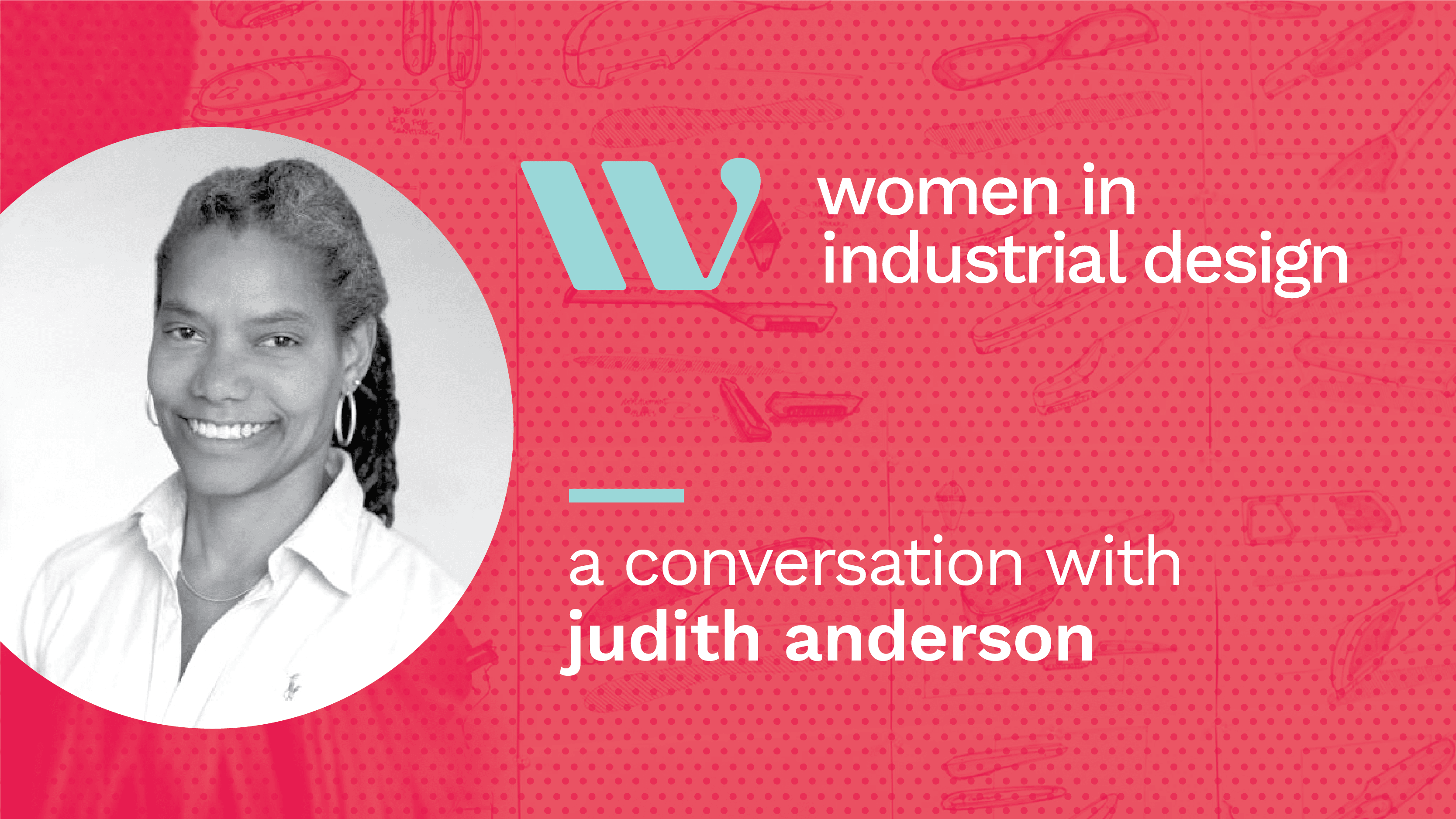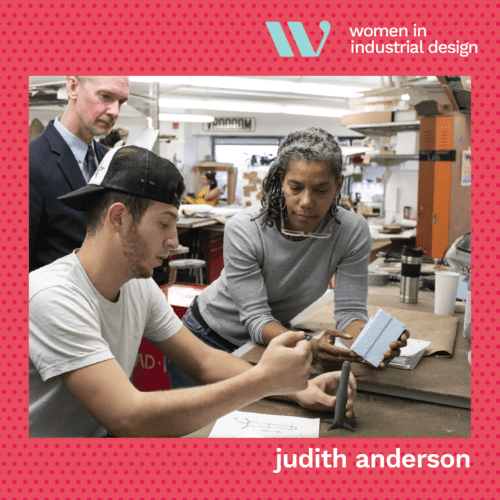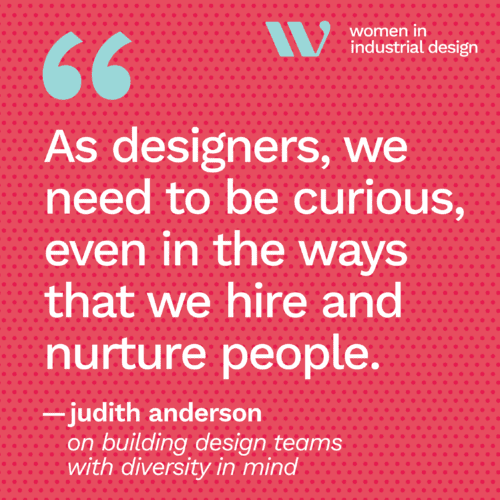Women in Industrial Design: A Conversation with Judith Anderson

Our team has spent the last year researching the issue of gender gap in the industrial design profession. Throughout this time, we’ve been interviewing women in the industry to hear their perspectives and, hopefully, start conversations that activate change.
This month we sought the input of an educator who crosses paths with hundreds of young designers each year as they begin their journey in this industry, Judith Anderson, Industrial Design Chair at MassArt. Judith began her design career in 1983 at GE, followed by several years providing design consultancy services in London. Her current focus is on curriculum development and creating collaborative and cross-discipline opportunities for students in the industrial design program. In the interview, Judith shared the advice she gives students as they prepare to enter the industry, and her perspective on the need for more diversity in design.
In the coming months, we plan to share the full series of interviews and our takeaways in book form with the community. We are looking forward to creating a meaningful piece that shines the spotlight on the incredibly talented women featured in it, and how the industry can better support and create more opportunities for others.


On the stereotypes placed around gender in the design space.
When we look at male and female traits, sometimes the same personality in a male could be considered positive, but in a female, they’re labeled ‘aggressive.’ That’s not a good thing. How did we get here? We have these stereotypes, these norms that we expect. Such as females are not mechanically inclined. Or, if they are then they must have had a really strong male role to help them get there.
But females DO have mechanical minds. Yet often from a very young age they are not encouraged to or allowed to explore that. Or they were discouraged. They could have innate talent, but no opportunity to develop it. There are a lot of things happening here that are systemic to the way that we live and think. We need to stop and question that, have a second thought, and be curious, even about the ways that we interact.
The stereotypes around the term ‘industrial design.’
The name itself can be problematic. ‘Industrial’ has a masculine undertone that is often associated with engineering. Instead of saying industrial design, people often say industrial engineering because they don’t understand industrial design as a topic. Even students have a hard time with it. A lot of Universities have gone through the transition to calling it ‘product design.’
Once students understand industrial design, they don’t want to let it go. They realize that even in conversations with their family and friends, where they have to explain it, in some ways it has an element of exclusivity. But there’s a downside because it doesn’t have a universal understanding.
On building design teams with diversity in mind.
Say you’re interviewing, and they ask, “Are you a good fit?” What does that mean, a “good fit?” What they’re really asking is, “Are you like us?” There’s a whole realm of people who hire people that are like themselves, never branching out to get to know other people or be exposed to other things.
You should always question your first choice when hiring, especially at a company where there’s always a “go-to” choice. You say, “Oh yeah, this is the one, this is the person, this is my first choice.” Ask yourself why? Is it because they seem like you? Do they have traits that mimic your ways of thinking? That’s not always good. Especially on a design team where you’re trying to provoke curiosity, push boundaries, and look at things from different perspectives.
There’s a comfort level with a go-to. It would be easier on the psyche if we don’t have to question what to do or how to do it. But as designers, we need to be curious, even in the ways that we hire and nurture people.
Looking at a range of individuals is a good thing. Maybe dig in a bit more in a way that feels connected to the ethos of your company. Find an opportunity to ask something personal from the candidates about what they do or how they view design. Something that allows them to show their personality a bit more. Provide an open invitation that says, “We want to hire all of you. Not just those parts of you that you think we want.” Find a way for individuals to bring themselves forward and feel comfortable.
As designers, we should be curious, even about our colleagues, and create an inclusive environment for everybody to be themselves.
On navigating the dynamics of being a female leader in the workplace.
At GE I was a lead design engineer running a development program with a team of 25 male engineers. In the development phase, we would visit manufacturers. When we walked in they always thought I was either the secretary or in marketing. Never the lead engineer on the project. It took my team to actually support me. That was several decades ago and we have made strides and yet there is much room for more.
In general, there’s a lack of perspective about how to take a step back, observe, listen, and create space for everyone to have a voice.
Sometimes it takes an individual to recognize what they see and the dynamics of the situation. Then to take a step back, recognize where they need to go, and redirect. There was an individual on my team who was a metallurgist 20 years my senior. We talked about this dynamic once in a while. He would be like, “Did you see what just happened?” Or, “Can you believe that just happened?” He would sit down in meetings and say, “I’d like to introduce you to the leader of the team. All the questions should go to her.”
Advice she gives her students as they prepare to enter the design industry.
On spending time abroad to stay inspired. Just be curious. Get exposed to different things. I love traveling — whether in your own neighborhood, outside of the country or even in the country. Get out of your comfort zone. I am the biggest advocate for students to get out of the country and study abroad. Our students have studied in London, Amsterdam, Canada, even Australia. I encourage getting out of the country as much as you can.
On mentors. Mentoring is very different from apprenticeship, and students need both. In the Boston area we have some great leaders and practitioners to teach the methodologies and skills these future designers will need to succeed. We also need to support the human: their personality, their ambitions, their maturity. There’s a lot of cookie-cutter advice. Many students feel like they failed if they didn’t do all the things their faculty wanted them to do. But they weren’t necessarily interested in that pursuit.
Mentoring is a two-way experience. It’s a matter of nurturing and supporting students’ particular skills and interests to empower them. Working together to figure out their role in the industry and what they need to thrive. You could get a lot of mentoring, but if it really isn’t tailored to you, it’s ineffective. You may live with self-doubt because you’re trying to live up to what someone else wants you to do. When in reality, it’s not your core strength or even your core connection. When we resonate with what we do at the CORE, we’re at our strongest, our baddest, and our best.
On internships. Everyone says you need internships, internships, internships. I think they’re great, and they can narrow students down in the beginning as they try to create that portfolio piece they think the company wants to see. There’s a balance between finding things that you really like to do and you’re curious about, versus doing things to fit in. The design field can surprise you with interesting opportunities you may not have thought of. You need to be open. Ask yourself: What is it that I want to do from a broader perspective? What is it that I feel I could do really well? What is it that I feel curious about that I want to try?
On first jobs. I talk to students all the time who say I just want a job in design. I just want that first job. Maybe I can morph a little to get that first position. I tell them you are valuable based on who you are. You have skills and talents that you should not let other people squash because they’re trying to make you into something else. It’s hard when you’re 20 to think that you’re talented in some way. You’re still striving to be better, do great things, and learn more. That is a good thing. But it is also important to hold onto the things that you do really well and to be proud of them. Find that balance. Don’t buy into the biases.
On second jobs. I tell students they’re lucky now because they’re not expected to hold a job for 10 years. Now it’s not a big deal — two years here, two years there — you’re moving around for a good reason. You’re developing a personality, an understanding of yourself, and the confidence to come forward as your true self.

